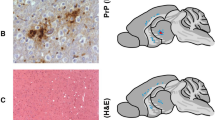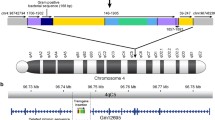Abstract
The prion protein (PrP), encoded by a chromosomal gene, is associated with development of the neurodegeneration of prion-induced diseases. Since determination of the complete structure of the gene encoding PrP is important for understanding gene expression in the central nervous system (CNS), the nucleotide (nt) sequence of the isolated whole gene encoding rat PrP (raPrP) was determined. The rat PrP gene (raPrP) spans 16 kilobases (kb) of the rat genome and contains three exons of 19–47 base pairs (bp), 98 bp, and 2 kb separated by two introns of 2.2 kb and 11 kb. The first and second exons are noncoding, while the third exon contains a short 5′ untranslated region, the entire 762-bp open reading frame (ORF), and a 3′ untranslated region. The putative raPrP promoter in the 5′ flanking region contains putative Sp1, AP-1, and AP-2 binding sites without a consensus TATA box. This TATA box-deficient feature, coupled with the presence of a high G+C content and Sp1-binding sites in the raPrP promoter, characterizes it as a housekeeping gene. Analysis of the raPrP cDNA 5′-end showed that raPrP mRNA transcription was initiated at multiple sites. Northern blot analysis showed that the levels of raPrP mRNA varied among rat tissues, with the highest levels found in the brain and placenta. This determination of raPrP nt sequences, including the introns and the 5′ and 3′ flanking regions, may make it possible to elucidate cis-acting elements that regulate the expression of this gene in different tissues and cell lines.
Similar content being viewed by others
References
PrusinerS.B., Science, 252 1515–1522, 1991.
PrusinerS.B., Science, 216, 136–144, 1982.
BaslerK., OeschB., ScottM., WestawayD., WalchliM., GrothD.F., McKinleyM.P., PrusinerS.B., and WeissmannC., Cell 46, 417–428, 1986.
WestawayD., CooperC., TurnerS., CostaM.D., CarlsonG.A., and PrusinerS.B., Proc Natl Acad Sci USA 91, 6418–6422, 1994.
SparkesR.S., SimonM., CohnV.H., FournierR.E.K., LemJ., KlisakI., HeinzmanC., BlattC., LuceroM., MohandasT., DeArmondS.J., WestawayD., PrusinerS.B., and WeinerL.P., Proc Natl Acad Sci USA 83, 7358–7362, 1986.
KuramotoT., MoriM., YamadaJ., and SerikawaT., Biochem Biophys Res Commun, 200, 1161–1168, 1994.
GomiH., IkedaT., KuniedaT., ItoharaS., PrusinerS.B., and YamanouchiK., Neurosci Lett 166, 171–174, 1994.
ChomcyznskiP. and SacchiN., Anal Biochem 162, 156–159, 1986.
FrohmanM.A., DushM.K., and MartinG.R., Proc Natl Acad Sci USA 85, 8998–9002, 1988.
SambrookJ., FritschE.F., and ManiatisT. Molecular Cloning. A Laboratory Manual, 2nd ed. Cold Spring Harbor Laboratory Press, Cold Spring Harbor, NY, 1989.
LiaoY-C., TokesZ., LimE., LackeyA., WooC.H., ButtonJ.D., and ClawsonG.A., Lab Invest 57, 370–374, 1987.
LochtC., ChesebroB., RaceR., and KeithJ.M., Proc Natl Acad Sci USA 83, 6372–6376, 1986.
WestawayD., GoodmanP.A., MirendaC.A., McKinleyM.P., CarlsonG.A., and PrusinerS.B., Cell 51, 651–662, 1987.
PuckettC., ConcannonP., CaseyC., and HoodL., J Hum Genet 49, 320–329, 1991.
BriggsM.R., KadonagaJ.T., BellS.P., and TjianR., Science 234, 47–52, 1986.
MitchellP.J., WangC., and TjianR., Cell 50, 847–861, 1987.
LeeW., MitchellP., and TjianR., Cell 49, 741–752, 1987.
WionD., BertM.L., and BrachetP., J Dev Neurosci, 64, 387–393, 1988.
LasmerasC., DeslysJ-P., and DormontD., Biochem Biophys Res Commun 196, 1163–1169, 1993.
BazanJ.F., FletterickR.J., McKinleyM.P., and PrusinerS.B., Protein Eng 1, 125–135, 1987.
EndoT., GrothD., PrusinerS.B., and KobataA., Biochemistry 28, 8380–8388, 1989.
StahlN., BaldwinM.A. BurlingameA.L., and PrusinerS.B., Biochemistry 29, 8879–8884, 1990.
ChesebroB., RaceR., WehrlyK., NishioJ., BloomB., LechnerD., BergstronS., RobbinsK., KeithJ.M., GaronG., and HaaseA., Nature 315, 331–333, 1985.
RobakisN.K., SawhP.R., WolfeG.C., RubensteinR., CarpR.I., and InnisM.A., Proc Natl Acad Sci USA 83, 6377–6381, 1986.
Author information
Authors and Affiliations
Rights and permissions
About this article
Cite this article
Saeki, K., Matsumoto, Y., Hirota, Y. et al. Three-exon structure of the gene encoding the rat prion protein and its expression in tissues. Virus Genes 12, 15–20 (1996). https://doi.org/10.1007/BF00369996
Received:
Accepted:
Issue Date:
DOI: https://doi.org/10.1007/BF00369996




